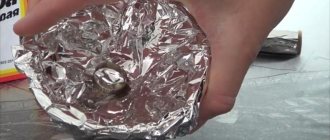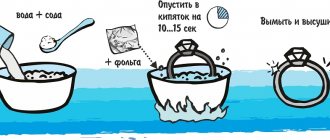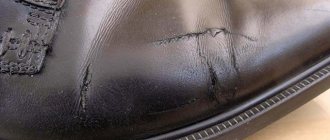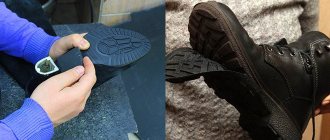Autumn and winter often become a real test of strength for boots and boots. Snow and puddles saturate them with moisture, leaving salt streaks. And the reagents scattered for the safety of pedestrians only aggravate the situation. Therefore, it is important to properly clean shoes from salt and protect them from adverse external influences.
Professional remedies against salt on shoes
You can remove salt from shoes using professional cleaning products:
- Detach Stain is a product that neutralizes salt stains from shoes made of any materials thanks to the vinegar in its composition. Apply to a sponge and apply to the stain. After a couple of minutes, wipe the treated area with a damp cloth, and after drying, lubricate it with protective cream.
- Tarrago De Salter is a handy pocket-sized solution against salt on leather and suede shoes. Contains fluorine. Before applying, shake the can, turn it down with a sponge, and treat the stained area. After a few minutes, wipe off the foam with a damp sponge.
- "Antisol" from Salton. Removes salt from smooth leather, nubuck and suede products. Consists of a complex of natural organic acids. Shake the can, apply the product to the shoes using a spray bottle, and immediately wipe off the salt stains (no need to wait until the composition dries). Lubricate the treated area with cream.
- “Water-repellent impregnation” from Salamander for textile, suede shoes, nubuck, velor, smooth leather, TEX membrane. The product contains fluoride. Apply to the dried, clean surface of the shoe at a distance of 20 cm, leave until completely dry.
These products will not only get rid of salt stains on shoes, but will also prevent their further occurrence.
Removing salt stains depending on the material
You can wash salt from shoes using either chemicals or homemade recipes only after determining the material from which the shoes are made. Leather, suede and nubuck have their own characteristics and processing rules.
Leather
Products made from natural materials are more difficult to clean, but get dirty more easily. Genuine leather has a porous structure, so salt settles on it quickly and for a long time. It must be washed immediately: wipe the boots with damp towels, then wrap them in napkins and leave to dry.
Vinegar essence helps remove salt from both natural and artificial leather shoes: you need to dilute the vinegar with water in a ratio of 1:4, then soak a cotton swab in the solution and treat the stains. At the end of the procedure, you need to wipe the boots with a damp cloth and let them dry.
Attention! Before applying the vinegar solution to the outside of the product, you need to check the reaction on the inside. If the material has not changed its structure and color, then the product can be considered harmless.
Suede
Since it is quite difficult to clean white salt stains on suede shoes due to the capricious material, stains should be removed as they appear.
We recommend:
How to remove plasticine from clothes
First of all, the surface is moistened with steam: a steam generator or a pan of boiling water is suitable for this. You should not wet suede boots under a tap, as the material may deteriorate. When steaming, do not hold shoes too close to the source, otherwise the seams may unravel.
If white spots appear, you need to take baking soda or tooth powder - they are poured onto the stain and left for a while. Once the ingredients have absorbed the salt, the powder can be removed using a soft brush.
Nubuck
A solution of laundry soap is suitable for this material - you need to wipe the stains with a soapy cloth, and then wipe off the product with a clean napkin.
Potato juice also helps: the starch neutralizes the salt, making it easy to remove after drying.
Leatherette
Artificial leather is more resistant to salt stains compared to natural leather. To remove salt, you can use medical alcohol or vodka: moisten a cotton swab and walk along the line of contamination. Then the boots are wiped with a damp cloth and dried.
Effective home remedies for leather shoes
Leather products are most susceptible to salt stains. Reagents accumulate in the seams, on the surface of the boots, and corrode the material from the inside. Professional and home remedies work well for cleaning.
Castor oil
Many people do not know how to remove salt from shoes after a walk. Castor oil is suitable for this purpose. Soak a cotton pad in it and gently wipe the contaminated areas after the shoes have dried. If after the first treatment white stains remain, the procedure is repeated. Old stains will have to be lubricated daily for a week.
You cannot use sunflower oil or any other oil instead of castor oil, as they can make your boots look untidy.
There is another recipe against salt stains on leather products. Mix castor oil (1 part) with fish oil (3 parts), place in a water bath until the fat dissolves. Apply the slightly cooled mixture onto the stains, leave for a couple of hours, and remove with a sponge soaked in water.
Vinegar
You can clean stains from reagents on shoes using vinegar essence (9%). 1 tsp. mix water with 3 tsp. vinegar. Wet a sponge in the resulting solution and wipe the contaminated surface. Then we dry the shoes, after half an hour we apply shoe polish to them. Re-processing may be required.
Aggressive solvents (gasoline, acetone, white spirit) cannot be used to treat shoes, as the paint may peel off.
Alcohol
It can also be used to remove salt stains from genuine leather products. Soak a piece of rag in alcohol and wipe the shoes along the stain line. To consolidate the result, we repeat the procedure.
Cleaning with vinegar
Prepare in advance a large basin for water, paper towels or cotton pads, a piece of clean cloth and white vinegar. Next, follow the instructions:
- Take leather shoes (boots, boots) in your hands and, using any narrow object, remove accumulations of salt and dirt in all seams.
- Prepare a solution of water and vinegar essence in a ratio of 1:2.
- Next, soak a paper towel with the mixture.
- Dry the surface of the leather thoroughly with a towel.
- After cleaning, wipe the boots with a dry cloth and dry them at room temperature.
- If the stains are removed, you can apply a protective cream and polish the skin. Polishing makes the surface smoother and more resistant to the harmful effects of salt.
- It is rare to remove stains the first time. Therefore, the procedure is carried out repeatedly, each time drying and polishing the shoes.
When cleaning shoes, you should not limit yourself to clearly damaged areas. After all, water saturates the entire surface, and there may be residual salts on it that are invisible. Therefore, just in case, it is better to do a full processing.
How to get rid of salt on suede shoes
Suede products require delicate care. To remove reagent residues from them, it is better to use professional means, but if you don’t have any at hand, effective folk methods will do.
Ammonia
Old stains can be removed with 1 tsp. soda, 2 drops of ammonia solution, 100 ml of milk. Soak a soft cloth in the solution and wipe the boots. Then use a damp cotton pad to remove the remaining solution along with the reagents.
Steam
Steam baths will help remove salt from shoes. To do this, boil water in a large container and place boots over the steam. They must be held so that the surface of the boots is slightly damp, since due to a large amount of water the material will harden and lose its shape. After such a steam bath, the remaining salt can be easily removed with a regular brush.
Potato
You can remove salt from shoes using raw potatoes, peeled and cut into two parts. We rub the stains with a cut of the tuber, leave until completely dry, and remove the remaining reagents with a brush for suede products.
The crumb of white or black bread has a similar effect.
Dentifrice
Helps quickly remove salt stains from autumn and winter suede boots. It is enough to evenly distribute the powder on contaminated areas. Within half an hour, the substance should absorb the salt.
Then the boots are cleaned with a brush or vacuumed.
How to remove a grease stain on clothes
No matter how hard you try to avoid encountering grease stains on your clothes, sooner or later they will end up on your favorite item. The fact is that we are surrounded by products that are based on a fatty base. And when dining at a restaurant, or trying to prepare a masterpiece of home cooking, the chances of getting grease on your clothes significantly increase.
In the modern world, an incredible amount of all kinds of stain removal products are produced. But they are not always available when the consumer is faced with a problem such as a greasy stain on everyday wardrobe items. And the cost of effective stain removers is quite impressive. Therefore, it is worth figuring out what home methods you can use to remove grease stains from clothes, using only those products that are at hand for any housewife.
It is worth noting that before you begin the stain removal process, you need to prepare the item. To do this you need to do the following.
At home, conventional products that are found in almost every kitchen have long demonstrated their effectiveness in combating traces of fat. Among them are:
Let's study in more detail the most reliable methods of removing fatty traces from fabric using these simple substances.
How to remove a greasy stain on clothes using salt
Regular table salt can become an indispensable assistant in the fight against stains on clothes of various origins. Using this component will help save your favorite item from unpleasant traces of grease, and will help remove traces with maximum efficiency and speed.
It is worth noting that the use of table salt as a stain remover has been practiced for a long time. However, we must not forget that table salt will not get rid of old stains. It will only work great on fresh stains. Therefore, when you put a greasy stain on your favorite clothes, do not delay, and try to deal with it as quickly as possible.
In order to remove a greasy stain from an item, you need to cover the area of the fabric exposed to grease with fine table salt. With careful movements, you need to wipe the fabric with salt, and after the fat begins to gradually be absorbed by salt crystals, the mixture will need to be removed from the clothes and a new portion of salt should be added. This procedure must be repeated until all the fat from the fabric is absorbed into the salt and leaves the fabric without a trace.
Speaking about how to remove an old grease stain from clothes using salt, it should be noted that this is quite possible. To combat the stain, you need to prepare a concentrated solution based on table salt. To do this, you can combine 0.5 cups of salt with warm water until it is completely dissolved, and treat the area of tissue damage. You can also simply soak the area of fabric that is prone to grease stains in warm water and sprinkle salt on top. After waiting 20-40 minutes, the clothes will need to be rid of salt and rinsed. For greater efficiency, the procedure will have to be done 2-3 times.
How to remove a greasy stain on clothes using laundry soap
Laundry soap has long gained fame as an excellent means of combating any kind of pollution. Grease stains are no exception, and laundry soap will definitely help eliminate them effectively and quickly.
In order to remove greasy stains on clothes, you need to rub a bar of soap with a grater and place the resulting substance on a section of fabric. After this, use gentle movements to rub the mixture into the stain and leave the item overnight. This method is ideal for cases where the stain is detected immediately after it appears and has not had time to dry.
You can also prepare a solution based on purchased laundry soap and soak the damaged fabric in it. To do this, grate a bar of soap and stir it in warm water until the soap component is completely dissolved. After this, the item must be placed in the resulting solution and left to lie there for several hours (as a rule, experienced housewives advise more than 5 hours). After the required time has passed, the fabric must be removed and washed in a way convenient for you.
If the trace of grease is fresh, and you need to get rid of it as quickly as possible, then you should rub the stain with ordinary laundry soap and sprinkle loose sugar on top of it. After this, the fabric should be left for 15-20 minutes, then the greasy mark should be washed off in warm water.
Baking soda is an assistant in the fight against greasy stains
Baking soda has long won a secluded place in every kitchen. This ingredient is used to create culinary delights, and in addition, soda is considered an excellent stain remover that anyone can use at home.
In order to remove a fresh grease stain from fabric fibers, sprinkle the damaged area of the fabric with soda and gently rub it into the greasy stain. Gradually, the fat will begin to leave the tissue and combine with the soda crystals. This operation will have to be repeated several times until the resulting trace of fat completely disappears.
If the above method does not provide much support, then you need to pour soda into warm water, and then add a few drops of ammonia there. The resulting substance should be mushy. It needs to be applied to the stain, and the soaked item should be left for several hours until the applied substance dries completely. After this, the soda must be carefully removed from the fabric, and the clothes must be washed by hand with laundry soap.
To remove old greasy marks, baking soda is often mixed with tooth powder (regular toothpaste is also suitable) and mustard powder. All components must be in equal proportions. After the product is ready for use, it must be applied with gentle movements to the fabric and left to stand for 1-3 hours in a dark and cool place. At the end of this time, the clothes should be washed in any way that is more acceptable in the given situation.
How to remove grease stains from clothes using ammonia
In order to get rid of greasy stains using ammonia, you must remember that this product is only suitable for dealing with greasy marks on white clothes. If you are thinking about how to remove grease stains from colored clothes, then it is better to refrain from using ammonia.
If the grease trace is fresh, then you just need to wipe the stain with a prepared solution of household ammonia, after which you will have to wait 15 minutes, and then thoroughly wash the item in your favorite washing machine. If the stain has already dried, then after using ammonia, you need to carefully wash the stain with warm water, dry it with an iron and wipe with hydrogen peroxide.
How to remove grease stains from clothes with vinegar
When talking about how to remove grease stains on clothes, it is impossible to ignore such an indispensable assistant as acetic acid. However, when using it, it is worth remembering that 9% vinegar will help as a stain remover. It should be noted that it is better not to use more concentrated vinegar-based products, since there is a high probability of completely destroying the item.
Experienced housewives claim that acetic acid is an indispensable aid when working with greasy stains on white clothes. To remove traces of grease, you need to carefully treat the damaged area with acetic acid, and then wash the item in running water using laundry soap.
If you need to remove a stain from colored clothing, it is better to use vinegar in combination with other products, for example, table salt and mustard powder. All these important and inexpensive components should be mixed in equal proportions and dissolved in warm water. After this, the area of damage to the fabric must be treated with the resulting composition and the fabric must be left for several minutes, after which it must be washed. If you have to work with an old stain, you need to soak the clothes in the resulting substance overnight and then wash them several times.
How to clean delicate fabrics from greasy stains with gasoline
Despite the fact that petroleum products are considered sources of greasy stains, they can also act as an effective means of combating them. If you have put a greasy mark on clothes made of delicate fabric, for example, silk, cashmere or viscose, then you should be especially careful in dealing with greasy marks so as not to damage the fabric and ruin the item.
Purified gasoline and blotting paper will do an excellent job of removing stains from delicate fabrics. You need to take two sheets of blotting paper and place them on both sides of the greasy mark on the fabric. Then you need to moisten a small cotton swab with purified concentrated gasoline and wipe the stain with gentle movements. Under the influence of gasoline fumes, the fat will transfer from the fabric to the blotting paper, which should be replaced over time.
The procedure should be repeated until no greasy marks remain on the fabric. After finishing cleaning, clothes should be washed in warm water. It is worth using both washing powder and conditioner.
How to remove old grease stains from clothes with starch
When talking about how to wash a greasy stain on clothes with your hands, you must remember that before doing this you need to treat the fabric with a cleanser. At home, ordinary potato starch can be an excellent stain remover.
It is worth noting that the use of the method of removing traces of fat from fabric using starch must be used in situations where the fabric cannot be washed. To completely get rid of the stain, you need to carefully apply a thin layer of starch to the stain and gently rub it. Next, you should leave the item alone for a few minutes (10-20 minutes). After the required period, the clothes will need to be carefully wiped with a damp cloth.
If we are dealing with an old stain, then the starch will need to be additionally heated. To do this, you need to apply starch to greasy marks on the fabric, cover it with a dry, clean cloth and run a heated iron several times.
The fat will gradually be absorbed into the starch, and after repeating several such procedures, your item will look like new, completely returning to its original condition.
Ammonia and turpentine are an ideal means of combating old greasy stains
One of the effective methods of combating old greasy marks on clothes is considered to be a combination of purified turpentine and pharmaceutical ammonia.
In order to remove stains from fabric, you need to mix purified turpentine (if you don’t have it on hand, you can get by with purified gasoline) and ammonia in equal parts. Next, you need to carefully apply the resulting substance to cotton wool and carefully wipe the stain several times. After performing this procedure, you need to leave the clothes for several hours, and only then you can wash them in warm water.
If we are dealing with delicate fabrics, then in this case it is necessary to mix the resulting mixture of ammonia and turpentine with crushed sawdust. After this substance is applied to the damaged area of the fabric, you must wait until the sawdust has dried, and only after these manipulations can you start washing.
How to remove salt from nubuck shoes
This material does not like water, so using it in large quantities for cleaning is not recommended. After a walk, nubuck boots should be thoroughly dried, then walked over their surface with a special brush with rubber bristles. You need to comb your shoes in different directions to avoid the lint sticking together. You can also use a regular or shoe eraser.
A soap solution in which a sponge is moistened and the stained areas are wiped will help get rid of any remaining reagents. The boots are dried in a warm room. Vinegar solution (1 tsp of essence per glass of water) removes traces of salt well.
It is better to remove salt stains from nubuck shoes point by point, applying cleaning products only to the stains.
How to remove grease stains from clothes
In everyday life, we often come across products that contain fatty components. Often, our clothes are left with hateful traces of grease, which are very difficult to remove, especially if there are no effective products at hand that will help in the fight against grease stains.
Many people know how to remove grease stains from clothes without resorting to dry cleaning. Still, some nuances should be taken into account.
Helpful tips for cleaning at home
Many people are interested in how to remove salt from shoes without harming them. Several rules must be followed:
- You should clean your shoes immediately upon arriving home. First, wipe them with a damp cloth or sponge. It is necessary to rinse the cloth frequently so as not to smear the salt.
- Particular attention is paid to the seams, since this is where the maximum salt accumulates. The seams can be scrubbed with a brush.
- Then you need to wrap the product in dry material or paper napkins so that excess moisture and salt are absorbed.
- Leave the shoes like this to dry. You can place it near the battery, but not close, but at a distance of 30-50 cm, so that the surface of the product does not deteriorate. In a couple of hours, all moisture should evaporate.
- After the boots have dried, they are inspected. If salt stains remain on them, you need to clean them using professional or folk remedies.
- Then the products are lubricated with a water-repellent compound or cream. You need to wait until it is absorbed and wipe the surface with a dry cloth.
- Suede shoes are cleaned with napkins and soap foam. It is also suitable for washing dirty shoe bases.
How can you remove greasy stains from clothes if traditional methods do not help?
In practice, getting rid of greasy marks on fabric can be extremely problematic, and often even time-tested folk remedies are not able to help cope with this task. If you are faced with such a problem, then the only way to effectively remove greasy marks from clothes is to use specialized chemical reagents.
You can remove even the oldest stains using any stain remover, which can be found in a huge selection at your nearest hardware store. They contain active components that will help remove traces of fat from fabric fibers, completely freeing the item from fat. Generally, stain removers are best used when dealing with old stains.
If the greasy marks on the fabric are fresh, then you can remove them with more affordable means - shampoos and dishwashing detergents. These substances will also perfectly remove greasy marks from fabric, but provided that not much time has passed since the grease hit the clothes and the stains have not dried out.
What to do to prevent salt stains from appearing
The appearance of salt stains can be avoided if you follow the rules for caring for shoes:
- Boots must be treated with special water-repellent agents (Salamander, Kiwi, TJ Collection), just do this in advance so that they have time to dry. Colorless wax is also suitable, which protects shoes well from dirt, moisture and reagents.
- On frosty days, it is better not to use silicone sponges and brushes. Silicone freezes, which can damage the material of the product. Reagents that get into microcracks are very difficult to remove from them.
- After each trip outside, be sure to wash leather boots with warm water, and clean suede boots with a brush.
- If salt remains on the surface of the shoes, special shoe paint can paint over the stains.
- You should not wear boots that are not yet completely dry, as reagents stick to a wet surface much faster. You can speed up the drying process by using a brush, which will remove excess moisture. A fireplace, radiators or fan should not be used to dry items faster.
On the street, you must try to avoid the dirty mess that consists of ice, snow and reagents. As a last resort, it is better to carefully walk through the puddle. In winter, give preference to shoes with thick soles or platforms so that less salt gets on the surface of the boots. It is better to wear suede products only at sub-zero temperatures.
Causes of white spots
The reasons why leather boots get dirty in winter and autumn are quite simple. Whitish or grayish stains on shoes appear under the influence of reagents that contain a high concentration of marble or salt. Upon contact with wet boots (especially if there is a lot of snow outside), these chemicals are absorbed into the leather or other material, and the salt crystallizes and comes out.
This phenomenon is dangerous because shoes quickly lose their presentation, while their service life is noticeably reduced. It is almost impossible to wash away ingrained salt and insidious white stains with plain water. In addition, frequent contact of leather or suede boots with moisture leads to damage to the material: mold may appear on the textile inserts.
When boots are exposed to reagents and wet snow, they must be immediately put in order at home. If this is not done, salt stains will remain for a long time.
The correct algorithm for cleaning wet shoes:
In order to return boots or shoes to an elegant look, you need to fight salt marks. The most reliable way to avoid damage to shoes is not to walk on roads sprinkled with the reagent or travel by car (public transport).
Store-bought products for removing white marks
In shoe stores you can find many suede sprays that not only carefully care for the delicate material, but also tint boots, ankle boots or boots. This is the easiest way to get rid of white stains: just apply a special product and leave for thirty to fifty minutes (according to the instructions). During this time, the chemical compounds that are included in purchased suede care sprays will carefully and effectively remove dirt.
Shoe protection
To protect different types of shoes from salt, many ready-made products have been invented in various forms: liquid, cream or spray. Don't forget to treat your boots with them before going outside. This will help the shoes and make it easier to deal with salt stains. You can also use home remedies:
soak a sponge in hair conditioner and wipe leather shoes. Allow the product to absorb; moisten a rag in vegetable oil and rub it into the leather of the shoes. The fat base will prevent the formation of streaks; wax is an excellent means of protection. Soften it and rub the shoes, then treat with a brush; melt the wax, pour in turpentine and castor oil. Apply the ointment to your boots thoroughly.
Cleaning boots with soapy water
If dry cleaning does not help, you can remove salt stains from suede shoes using a soap solution. To prepare the solution, it is better to take a mild shampoo without fragrances or specific additives. You need to clean your boots in a circular motion; do not get the product too wet - this will only further encourage the dirt to become embedded.
Paper and baby cream
To properly use such an unusual tandem, you need to apply a simple operating algorithm:
- When you leave the street, immediately rinse your shoes with lukewarm water.
- Wrap salted areas in paper or paper napkins.
- Leave this pair for a while.
- During the drying process, salt from the surface of the shoe will be absorbed into the paper.
- Treat dry shoes with baby cream. It will protect it from external factors (including salt absorption) and polish it.










